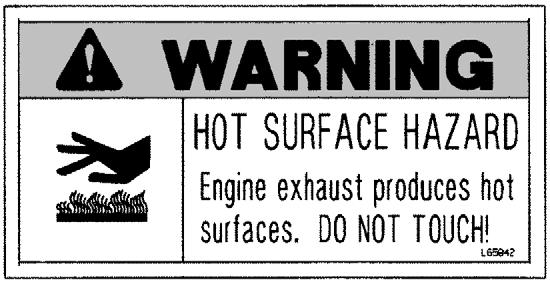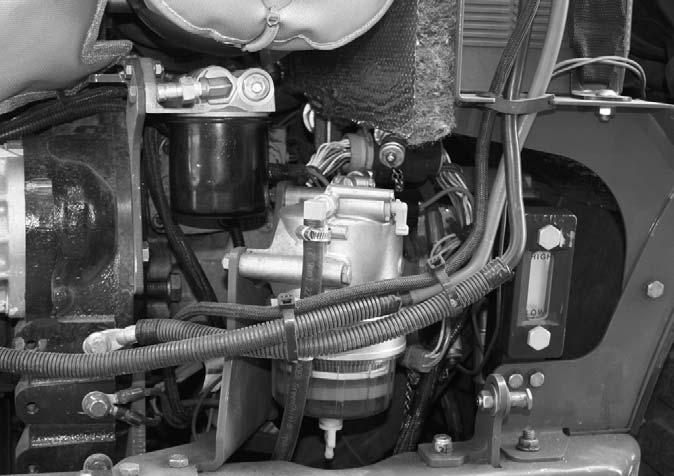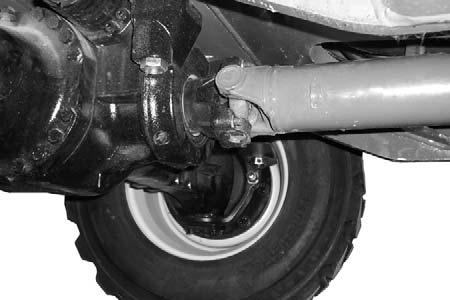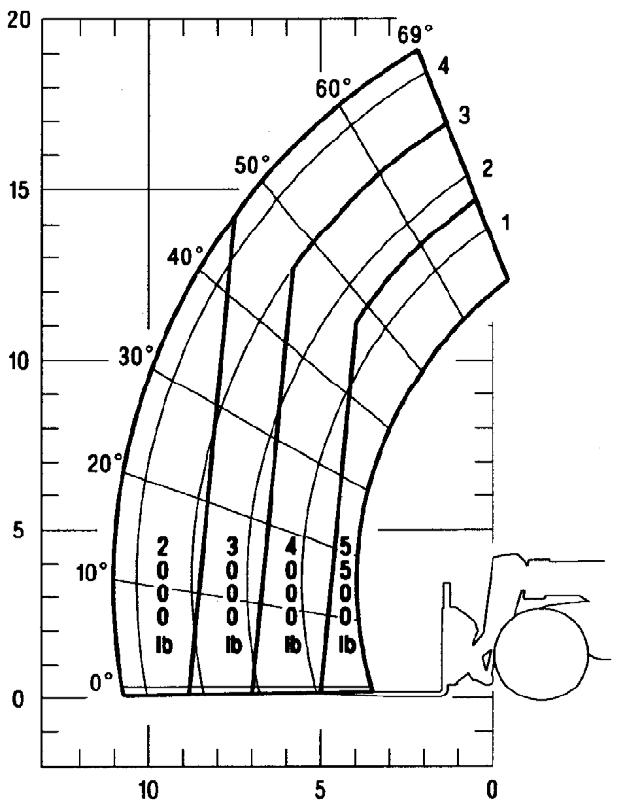
12 minute read
Safety Hand Signals
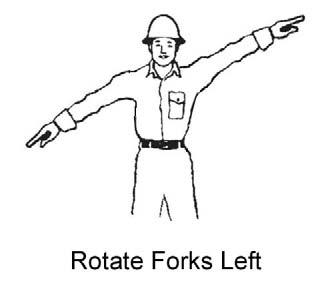




When ramps must be used in transporting loads with the machine, the following are the minimum widths for safe travel:
Compacted dirt, gravel, etc.12 ft. (3.6 m)
Woodboard, concrete, etc.10 ft. (3.0 m)
Permanent aisles, roadways and passageways, floors and ramps must be clearly defined or marked. Permanent or temporary protrusion of loads, equipment, material and construction facilities into the usual operating area must be guarded, clearly and distinctively marked, or clearly visible.
Maintain a safe distance from the edge of ramps, platforms and other similar working surfaces.
Controlled lighting of adequate intensity should be provided in operating areas. Where operating conditions indicate, the operator/user is responsible for having the machine equipped with lights.
Provisions must be made to prevent trucks, semi-trailers and railroad cars from being moved during loading and unloading.
Wheel stops, parking brakes, or other positive holding means must be used to prevent movement during loading and unloading.
DO NOT move railroad cars and trailers with the Telescopic Handler.
DO NOT use the boom and attachment for leverage to push the machine out of mud.
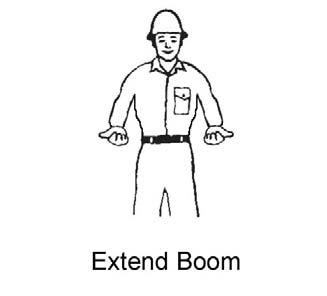

IMPORTANT: DO NOT lower boom at high engine speed when attachment tool is at maximum rearward tilt, because damage to slave cylinders may result.
General Load Handling
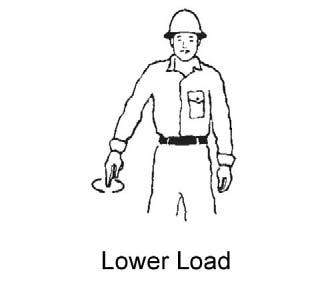



NEVER attempt to work controls except from the operator’s seat. NEVER jerk or use fast movements. Avoid sudden stops, starts and changes in direction.
Operation of the hydraulic system depends on engine speed and the distance the controls are moved. When operating these controls it is important to develop a technique called “feathering.” Feathering the control means starting the desired motion by moving the control a small amount away from neutral. Then after movement has started, the control can be eased to full movement. Use the same feathering technique to stop the motion.
Warning
Excessive speed can be hazardous. ALWAYS exercise caution and good judgement while operating the machine.
ALWAYS maintain a safe distance from electric power lines and avoid contact with any electrically charged conductor and gas line. It is not necessary to make direct contact with a power line for power to ground through the structure of the machine. Keep the boom and load at least 10 ft. (3 m) from all power lines. Accidental contact or rupture can result in electrocution or an explosion. Contact the North American One-Call Referral System at (888) 258-0808 for the local “Digger’s Hotline” number or proper local authorities for utility line locations BEFORE starting to dig!
Keep all body parts inside the operator’s station while operating the machine. BE SURE of clearance for the attachment tool when turning, working around buildings, etc.
Turning corners too fast can tip the machine, or cause a load to tip off the attachment. Sudden slowing or stopping of the machine may cause the load to drop off the attachment tool.
Be certain you can control both speed and direction before moving. Always place the machine in neutral and set the parking brake before raising or extending the boom. NEVER drive the machine up to someone standing in front of the load.
NEVER leave the operator’s station without first lowering the attachment tool to the ground. Then set the parking brake, place controls in neutral, shut off engine and remove the key. AVOID parking the machine on a slope, but if necessary, park across the slope and block the tires.
Load Capacity and Reach
This machine has flip-charts in the operator’s station that provide the load capacity limits at various positions of attachment tool extension and elevation. A set of the load zone charts is reproduced at the end of this manual for reference.
A typical load zone chart is shown below. The scale on the left indicates height in feet above the ground level. The scale on the bottom shows the distance in feet out from the front of the machine. The arc lines noted by the numbers “1” through “4” correspond to the position extension markers on the operator side of the inner boom section.
The following example illustrates proper use of the load zone charts for the Telescopic Handler:
Example:
The operator, using a standard carriage attachment tool, wants to raise a 4000 pound load 10 feet high, and can only get to within 5 feet of the load placement point. Can it be done within the capacity of the machine?
Analysis: See “Typical Load Zone Chart” below.
Projecting up from the 5-foot mark on the horizontal axis to intersect a line through the 10-foot mark on the vertical axis shows the load can be placed in the 4000 pound zone.
During placement, the operator observes when the extension reference number “2” on the boom becomes visible and stops. The maximum safe distance of extension with this load has been reached.
Warning
NEVER exceed the rated operating capacity of the Telescopic Handler as shown on the load zone charts.

HANDLING NON-SUSPENDED LOADS
Picking Up the Load
Inspect the load. If it appears unstable, DO NOT attempt to move it. DO NOT attempt lifting doubletiered loads, or straddling side-by-side pallets with one on each fork. NEVER add extra unauthorized counterweights to this machine.
Approach the load squarely and slowly with the machine straight and level. Adjust the space between forks, if necessary. Engage the load equally on both forks until the load touches the carriage backrest. Tilt the forks back to position the load for travel.
Warning
Operating conditions can reduce the telehandler’s safe operating capacity. Exceeding the capacity when raising or extending the boom will cause the telehandler to tip forward.
Carrying the Load
If the load obstructs your view, get someone to direct you. Maintain ground speeds consistent with ground conditions and which permit stopping in a safe manner.
Warning
NEVER travel with the boom above the carry position (attachment tool should be at minimum ground clearance). Boom should be fully retracted.
NEVER coast with the transmission in neutral. Travel up and down grades slowly.
DO NOT operate the machine on a slope or grade that exceeds 22% or 12o.
Elevating and Placing the Load
For ground level load placement, be sure the area under the load and around the machine is clear of equipment and personnel. Lower the load to the ground, tilt the forks to the horizontal position, and then carefully back away to disengage forks from the load.
For elevated or overhead placement, bring the machine as close as possible to the landing point, and then:
Warning
DO NOT raise the boom until you check the frame angle indicator to verify that the ball is in a safe zone for raising and placing a high load.
1.Use extreme caution for high placement. Be sure personnel are clear of the area where the load or the machine could tip or fall.
Warning
Be sure that the surrounding ground has adequate strength to support the weight of the machine and the load it is carrying. Always wear the seat belt provided to prevent being thrown from the machine. If you are in an overturn:
- DO NOT jump!
- Hold on tight and stay with the machine!
- Lean away from the fall!
2.Set the parking brake, hold the service brake pedal in fully applied position and slowly raise the load, maintaining a slight rearward tilt to cradle the load.
3.As the load approaches the desired height, feather the boom control at minimum speed until the load is slightly higher than the landing point.
4.Continue the feathering technique and lower the load into place.
5.Free the forks from the load by alternately retracting and raising the boom. If this process is not possible, very slowly and carefully reverse the telescopic handler to free the forks from the load.

6.Lower the forks to travel height.
Warning
The machine becomes less stable as the load is raised higher.
Before raising a load, be sure the Telescopic Handler is within the safe lifting parameter as indicated by the frame angle indicator.
If a hydraulic boom circuit hose should break with the boom up, shut down the machine. DO NOT attempt to bring down the boom or make repairs. Call your Gehl dealer immediately.
As lift height increases, depth perception decreases. High elevation placement may require a signal person to guide the operator.
DO NOT ram the lift cylinder to the end of the stroke. The resulting jolt could spill the load.
A jib or truss boom should ONLY be used to lift and place loads when the machine is stationary and the frame is level. Transporting suspended loads must ALWAYS be done slowly and cautiously, with the boom and load as low as possible. Use taglines to restrict loads from swinging, to avoid overturns.
Handling Suspended Loads
Determine the weight and load center of the load to be handled. Refer to the telehandlerload chart to determine if the load can safely be handled.
Warning
NEVER exceed the rated operating capacity of the telehandler as shown on the load zone charts.
Warning
Operating conditions can reduce the machine’s safe operating capacity. Exceeding the capacity when raising or extending the boom will cause the machine to tip forward.
Picking Up Suspended Load
1.Rigging should be in good condition and rated for the load being lifted.
2.Rigging should comply with OSHA regulation §1910.184, “Slings,” or §1926.251, “Rigging equipment for material handling.”
3.Be sure the rigging equipment is clear of any part of the machine or machine attachment before lifting the load.
4.Avoid lifting double-tiered or any unstable loads.
5.Only lift loads vertically and clear from any adjcent obstacles. Never drag the load horizontally.
6.Use multiple lift points and taglines to restrain the load from swinging or rotating.
Carrying Suspended Load
1.Rigging between the load and attachment should be as short as possible to reduce boom height.
2.Do not raise the load more than 12 inches (305 mm) above the ground or raise the boom more than 45 degrees.
3.All telehandler movements should be performed slowly and cautiously to prevent load swing. Avoid abrupt movement. Do not exceed walking speed.
4.Use a signal person anytime the load restricts the operators view or assistance is required. The signal person should remain in contact (verbally or visually) with the operator at all times until the load is placed.
Ground Level Suspended Load Placement
1.Be sure the area under the load and around the telehandler is clear of equipment and personnel.
2.Lower the load to the ground till load is stationary and the rigging is loose from the load. Have signal person disconnect the rigging from the load.
3.Raise boom enough to clear the rigging from the load before backing the telehandler away from the load.
Elevated Suspended Load Placement
1.Bring the telehandler as close as possible to the landing point.
2.Check the frame angle indicator to verify that the ball is in the safe zone for placing a elevated load. Use extreme caution for high placement. Be sure personnel are clear of the load landing area.
3.Set the parking brake, shift the transmission into neutral, hold the service brake pedal fully applied and slowly raise the load.
4.As the load approaches the landing point, feather the boom control at minimum speed until the load is just above the landing point.
5.With the assistance of a signal person, continue the feathering technique to lower the load into place.
Warning
NEVER place the signal person between the load and the telehandler or other stationary objects.
6.Once the load is stationary on the landing point and the rigging is loose from the load, have the signal person disconnect the rigging from the load.
7.Raise boom enough to clear the rigging from the load. Slowly and carefully, reverse the telehandler till the rigging is clear of the load.
8.Lower the boom to travel height.
Road Travel
For short distance highway travel, attach a SlowMoving Vehicle (SMV) emblem (purchased locally) to the rear of the Telescopic Handler. For highway operation, obtain and install an amber flashing beacon.
NOTE: ALWAYS follow ALL state and local regulations regarding the operation of equipment on or across public highways. Whenever there is an appreciable distance between jobsites, or if driving on public highway is prohibited, transport the machine using a vehicle of appropriate size and capacity.
Transporting Between Jobsites
ALWAYS abide by the following recommended procedures and guidelines when using ramps to load the machine onto (and unload it from) a truck or trailer. Failure to heed can result in damage to equipment and serious personal injury or death!
Tie-down points are provided for inserting chains to secure the machine during transport.

Loading Machine Using Ramps
NOTE: A matched pair of ramps is required.
Ramp Placement
1.The ramps MUST be of sufficient strength to support the machine. Whenever possible, the use of strong steel ramps is recommended as well as center supporting blocks.
2.The ramps MUST be firmly attached to the truck or trailer bed with NO step between the bed and the ramps.
3.Incline of ramps MUST be less than 15 degrees. Ramp length MUST be at least 16 feet (4.9 m) long.
4.Ramp width MUST be at least 1-1/2 times the tire width.
5.Block the front and rear of the tires on the truck or trailer; engage the parking brake.
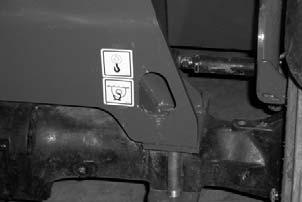
6.Position the machine with the boom facing toward the front of the truck or trailer so that it is straight in line with the ramps. Slowly (at the lowest engine speed possible) and carefully drive the machine up the ramps.
7.Tie-down points are provided at the front and rear corners of the frame structure.
Warning
NEVER adjust travel direction (even slightly) while on the ramps. Instead, back off the ramps, and then realign the machine with the ramps.
Warning
NEVER transport the machine with the boom raised or extended. BE SURE to secure the machine (including boom) to the truck or trailer bed using chain and binders or steel cables, to prevent any movement while transporting.
Unloading Machine Using Ramps
NOTE: A matched pair of ramps is required.
Repeat Steps 1 through 5 and proceed as follows to unload the machine:
6.Remove the tie-down chains/cables.
7.If necessary, adjust the machine so that the wheels are in line and centered with the ramps.

8.Slowly (at the lowest engine speed possible) and carefully drive the machine down the ramps.
Lifting The Telescopic Handler
The Telescopic Handler can be lifted using the four lifting points shown above.
Lift equipment used and its installation is the responsibility of the party conducting the lift. All rigging must comply with applicable regulations and guidelines.
Warning
Before lifting, check the lifting equipment for proper installation.
-Never allow riders in the operator’s station while the telescopic handler is lifted.
-Keep everyone a safe distance away from the telescopic handler while it is lifted.
-The telescopic handler may only be lifted without a load on the forks, or without an attachment. Never lift the telescopic handler with attachment other than those stated.
1.Using suitable lift equipment, hook into the lift eyes. Adjust the length of the slings or chains to lift the telescopic handler level.
IMPORTANT: As needed, use a spreader bar to prevent the slings or chains from rubbing the sides of the boom.
2.Center the hoist over the Telescopic Handler. To prevent shock loading of the equipment and excessive swinging of the load, slowly lift the Telescopic Handler off the ground. Perform all movements slowly and gradually. As needed, use a tag line to help position the Telescopic Handler.
Towing The Telescopic Handler
Warning
Do not tow the Telescopic Handler at more than 3 mph (5 km/h), and only for short distances (less than 100 yards).
If the machine becomes disabled, it can be towed for a short distance. To tow the Telescopic Handler, the high pressure limiters on the hydrostatic transmission must be unlocked and the SAHR parking brake must be released.
Hydrostatic Transmission Unlocking Procedure



1.Remove the plastic caps on the high pressure limiters.
Upper High Pressure Limiter with Cap Removed
Lower High Pressure Limiter with Cap Removed
2.Loosen the jam nut on a high pressure limiter.
Release Screw

3.While holding the jam nut, use an Allen wrench to turn the center release screw in until it bottoms.
4.Tighten the jam nut.
5.Repeat steps 2-4 for the other high pressure limiter.
SAHR Parking Brake Releasing Procedure
1.There are unlocking screws on the front and rear sides of the axle. Locate and loosen both unlocking screws (1) and remove the stop washers (3).
Warning
Before the Telescopic Handler can be returned to service, the SAHR parking brake must be returned to the applied position, and the hydrostatic transmission high pressure limiters must be locked.
SAHR Parking Brake Applying Procedure
1.Loosen the unlocking screws (1) and re-install the stop washers (3).
2.Tighten the unlocking screws against the stop washers.
Hydrostatic Transmission Locking Procedure
1.Loosen the jam nut on a high pressure limiter.
2.Using an Allen wrench, turn the center release screw back out until it stops.
3.Tighten the jam nut.
4.Repeat steps 1-3 for the other high pressure limiter.
Theft Deterrents
Gehl has recorded all major component part numbers and serial numbers. Users should take as many of the following actions as possible to discourage theft, to aid in the recovery in the event the machine is stolen, and to reduce vandalism:
1.Remove keys from unattended machines.
2.Attach, secure, and lock all anti-vandalism and anti-theft devices on the machine.
3.Lock doors of cabs when not in use.
4.Inspect the gates and fences of the equipment storage yard. If possible, keep machines in well-lighted areas. Ask the local law enforcement agency to make frequent checks around the storage and work sites, especially at night, during weekends, and on holidays.
5.Report any theft to your dealer and insurance company. Provide the model and all serial numbers. Request your dealer to forward this information to Gehl Company.


